Fighting The Never-Ending
Battle On Your Game System
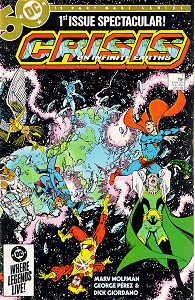 As far as my growing-up was concerned, my introduction to the comicbook world
of superheroes was through television -- seeing reruns of The Adventures Of
Superman with George Reeves and Batman with Adam West and Burt Ward
as the Dynamic Duo, plus the Hanna-Barberra cartoon show Superfriends
which gave us the classic team-up of Superman, Batman, Robin, Wonder Woman,
and Aquaman all working together for the common goal of truth and justice.
I didn't really get into superhero comics until 1985, when DC Comics published
its classic 12-issue limited series event Crisis On Infinite Earths,
where it seemed that the entirety of their superhero publishing line (plus
some of their nonsuperhero characters and some of their new acquisitions from
Charlton Comics like Blue Beetle and Captain Atom) was involved in dealing
with a greater threat that would devour their universes -- something that
would have made for great Saturday morning cartoon watching had DC Comics
allowed Hanna-Barberra to animate the entire epic to the best of their
ability.
As far as my growing-up was concerned, my introduction to the comicbook world
of superheroes was through television -- seeing reruns of The Adventures Of
Superman with George Reeves and Batman with Adam West and Burt Ward
as the Dynamic Duo, plus the Hanna-Barberra cartoon show Superfriends
which gave us the classic team-up of Superman, Batman, Robin, Wonder Woman,
and Aquaman all working together for the common goal of truth and justice.
I didn't really get into superhero comics until 1985, when DC Comics published
its classic 12-issue limited series event Crisis On Infinite Earths,
where it seemed that the entirety of their superhero publishing line (plus
some of their nonsuperhero characters and some of their new acquisitions from
Charlton Comics like Blue Beetle and Captain Atom) was involved in dealing
with a greater threat that would devour their universes -- something that
would have made for great Saturday morning cartoon watching had DC Comics
allowed Hanna-Barberra to animate the entire epic to the best of their
ability.
Superhero comics have allowed readers to vicariously partake in adventures far
beyond the realm of normal human experience for the past 65-plus years, even
as TV and film would try to translate the superhero experience with varying
degrees of success over the same period of time. Videogames, however,
would try to bridge the gap of fuller interaction with the heroes we came to
admire on the four-color pages, so with the first popular videogame system
that would allow for interchangeable games to be played on it like the Atari
2600, there would come the first videogame based on the great-grandfather of
all superheroes himself -- Superman.
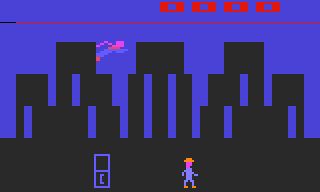 Graphically speaking, Superman for the 2600 had a very rudimentary look
to it that definitely dates it to the late 1970s when programmers of the
system were struggling with its very technical limitations to present a
reasonable graphical facsimile of what imagery they were trying to emulate
onscreen. Superman and all his related characters, including Lex Luthor
(at that time, a common criminal genius used to wearing a purple-and-green
bodysuit and always getting sent to prison when his latest anti-Superman plot
has failed) and Lois Lane, had a very stick-figurely look to them, and their
Metropolis really wasn't much to look at, with only variations of simple
background buildings and two windows for rooms that can be entered into.
The story itself was a pretty basic plot that worked well with the 2600's
constraints of memory, graphics, and sound -- the Metropolis Memorial Bridge
blows up, and Superman must gather up all the suspects behind its destruction
and fix the bridge while avoiding Kryptonite meteors floating around to strip
him of his powers upon contact (Superman here can only fly, pick up people and
things, and see into other places with his X-ray vision in this game) and the
only way to restore his powers is through contact with Lois Lane.
Graphically speaking, Superman for the 2600 had a very rudimentary look
to it that definitely dates it to the late 1970s when programmers of the
system were struggling with its very technical limitations to present a
reasonable graphical facsimile of what imagery they were trying to emulate
onscreen. Superman and all his related characters, including Lex Luthor
(at that time, a common criminal genius used to wearing a purple-and-green
bodysuit and always getting sent to prison when his latest anti-Superman plot
has failed) and Lois Lane, had a very stick-figurely look to them, and their
Metropolis really wasn't much to look at, with only variations of simple
background buildings and two windows for rooms that can be entered into.
The story itself was a pretty basic plot that worked well with the 2600's
constraints of memory, graphics, and sound -- the Metropolis Memorial Bridge
blows up, and Superman must gather up all the suspects behind its destruction
and fix the bridge while avoiding Kryptonite meteors floating around to strip
him of his powers upon contact (Superman here can only fly, pick up people and
things, and see into other places with his X-ray vision in this game) and the
only way to restore his powers is through contact with Lois Lane.
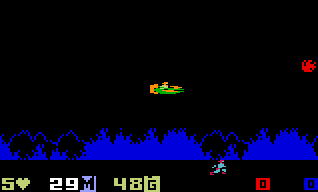 Despite its limitations, Superman was the only workable and
nearly-successful videogame based on a superhero in existence at the time
until Parker Brothers put Marvel Comic's Spiderman in his own Atari
2600 videogame in the early 1980s, a game that would mix elements of Taito's
Crazy Climber arcade game with Activision's Pitfall!, where the
red-and-blue-clad webslinger must climb a building to defuse bombs set up by
his archnemesis the Green Goblin while avoiding the glider-flying freakazoid's
henchmen as well as power lines, and also watching the web fluid meter that
would send Spidey falling to his doom when it runs out. Mattel, in the
meantime, gave Intellivision and Atari 2600 owners a game based on their
Masters Of The Universe toy line of the 1980s featuring their superhero
He-Man pursuing the villainous Skeletor across the landscape of Eternia in his
airship on his way to the climactic confrontation inside Castle Greyskull.
Despite its limitations, Superman was the only workable and
nearly-successful videogame based on a superhero in existence at the time
until Parker Brothers put Marvel Comic's Spiderman in his own Atari
2600 videogame in the early 1980s, a game that would mix elements of Taito's
Crazy Climber arcade game with Activision's Pitfall!, where the
red-and-blue-clad webslinger must climb a building to defuse bombs set up by
his archnemesis the Green Goblin while avoiding the glider-flying freakazoid's
henchmen as well as power lines, and also watching the web fluid meter that
would send Spidey falling to his doom when it runs out. Mattel, in the
meantime, gave Intellivision and Atari 2600 owners a game based on their
Masters Of The Universe toy line of the 1980s featuring their superhero
He-Man pursuing the villainous Skeletor across the landscape of Eternia in his
airship on his way to the climactic confrontation inside Castle Greyskull.
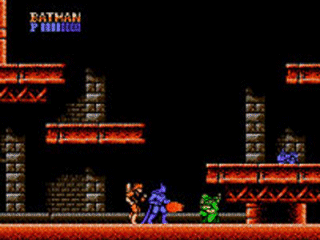 Batman, the only other long-running popular superhero character that DC Comics
created, would remain a foreigner to videogames until around 1990, when
Sunsoft based his first videogame made for the NES around the first Warner
Bros. movie released the previous year with Michael Keaton as the Dark Knight
and Jack Nicholson as the nefarious Joker. Batman: The Video Game
was a challenging run-and-jump platform game that took players through the
dark world of Gotham City, dealing with various thugs and booby-traps set up
by the Clown Prince of Crime to run as interference to prevent our black-clad
hero from reaching his final confrontation with the white-faced fixed-smiling
fiend. The movie's sequel, Batman Returns, would be converted by
both Konami for the NES and Super NES and by Sega for the Genesis, Sega CD,
and Game Gear, where Batman is faced with the deadly duo of Penguin and
Catwoman who are out to make Christmas in Gotham City anything but a joyous
occasion of "silent night, holy night". Unfortunately, the
third movie, Batman Forever, which would have made an excellent home
game since it had introduced Batman's lifelong partner Robin, ended up being
crafted into an awful mix of Mortal Kombat and Flashback under
the dubious guidance of Acclaim for both the 16-bit game systems and the
Nintendo and Sega handhelds.
Batman, the only other long-running popular superhero character that DC Comics
created, would remain a foreigner to videogames until around 1990, when
Sunsoft based his first videogame made for the NES around the first Warner
Bros. movie released the previous year with Michael Keaton as the Dark Knight
and Jack Nicholson as the nefarious Joker. Batman: The Video Game
was a challenging run-and-jump platform game that took players through the
dark world of Gotham City, dealing with various thugs and booby-traps set up
by the Clown Prince of Crime to run as interference to prevent our black-clad
hero from reaching his final confrontation with the white-faced fixed-smiling
fiend. The movie's sequel, Batman Returns, would be converted by
both Konami for the NES and Super NES and by Sega for the Genesis, Sega CD,
and Game Gear, where Batman is faced with the deadly duo of Penguin and
Catwoman who are out to make Christmas in Gotham City anything but a joyous
occasion of "silent night, holy night". Unfortunately, the
third movie, Batman Forever, which would have made an excellent home
game since it had introduced Batman's lifelong partner Robin, ended up being
crafted into an awful mix of Mortal Kombat and Flashback under
the dubious guidance of Acclaim for both the 16-bit game systems and the
Nintendo and Sega handhelds.
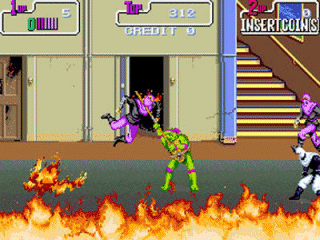 Not to be outdone by the main staples of comicbook superheroes, Kevin Eastman
and Peter Laird's Teenage Mutant Ninja Turtles, an independent publisher's
mid-1980s creation which inverted the concept of the superhero to where the
standard plot device of mutation gave four ordinary baby turtles humanlike
forms, personalities, and abilities trained and perfected by a mutated rat that knew
martial arts, became the subject of both home and arcade games developed by
Konami. Ultra's Teenage Mutant Ninja Turtles for the NES was an
adventure game where players could switch off among the four turtle warriors
and use their individual abilities and strengths to solve puzzles and fight
against the mutant and mechanical minions of Krang and Shredder.
Konami's arcade game of the same name is more of a standard fighter-fest where
up to four players can join in beating up on the endless army of Foot Clan
soldiers and other robotic creations while proceeding to rescue the
investigative reporter April O'Neil and their master Splinter from Krang and
Shredder. These games made the players feel like they were in the
cartoon themselves donning the colorful masks of the reptile heroes and
kicking major shell -- a feat that was repeated when Konami brought out new
games based on the recently-resurrected Turtles' new cartoon show.
Not to be outdone by the main staples of comicbook superheroes, Kevin Eastman
and Peter Laird's Teenage Mutant Ninja Turtles, an independent publisher's
mid-1980s creation which inverted the concept of the superhero to where the
standard plot device of mutation gave four ordinary baby turtles humanlike
forms, personalities, and abilities trained and perfected by a mutated rat that knew
martial arts, became the subject of both home and arcade games developed by
Konami. Ultra's Teenage Mutant Ninja Turtles for the NES was an
adventure game where players could switch off among the four turtle warriors
and use their individual abilities and strengths to solve puzzles and fight
against the mutant and mechanical minions of Krang and Shredder.
Konami's arcade game of the same name is more of a standard fighter-fest where
up to four players can join in beating up on the endless army of Foot Clan
soldiers and other robotic creations while proceeding to rescue the
investigative reporter April O'Neil and their master Splinter from Krang and
Shredder. These games made the players feel like they were in the
cartoon themselves donning the colorful masks of the reptile heroes and
kicking major shell -- a feat that was repeated when Konami brought out new
games based on the recently-resurrected Turtles' new cartoon show.
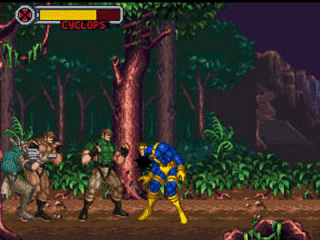 Which brings us to our next superhero sample: The X-Men by Marvel. A
group of mutant heroes who have been given a headquarters by the
perpetually-paraplegic Professor X, they have also appeared in various
videogames from the Nintendo era onward, the best of them being from Sega and
Capcom for the 16-bit era game systems. Capcom in addition produced an
arcade one-on-one fighting game where players could take on Street Fighter
II characters using Marvel superhero characters and their various powers,
or for those players who still argue over which superhero is the best, can
take the Marvel characters into a grudge match with each other. Sunsoft
and Acclaim also brought this idea to the table with the 16-bit game system
release of Justice League, where various DC Comics superheroes that
made up the core of that team are faced off against each other in some silly
plot that would require for such to happen.
Which brings us to our next superhero sample: The X-Men by Marvel. A
group of mutant heroes who have been given a headquarters by the
perpetually-paraplegic Professor X, they have also appeared in various
videogames from the Nintendo era onward, the best of them being from Sega and
Capcom for the 16-bit era game systems. Capcom in addition produced an
arcade one-on-one fighting game where players could take on Street Fighter
II characters using Marvel superhero characters and their various powers,
or for those players who still argue over which superhero is the best, can
take the Marvel characters into a grudge match with each other. Sunsoft
and Acclaim also brought this idea to the table with the 16-bit game system
release of Justice League, where various DC Comics superheroes that
made up the core of that team are faced off against each other in some silly
plot that would require for such to happen.
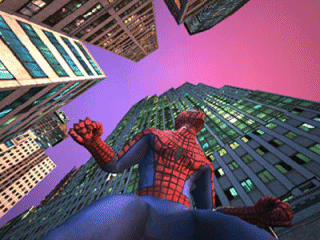 With the current state of videogame technology, game publishers are pushing
for ever-increasing realism in presenting superhero adventures that players
can feel like they're actually taking part in. For example, the Hulk
game released last year for the Playstation 2, X-Box, and GameCube, to
coincide with the motion picture of the same name, gave players a real taste
of being the green overmuscled bruiser out on a rampage to destroy anything
that got in his way. Unfortunately, not all superheroes enjoy having
excellent games being developed around their abilities and their adventures.
Superman, who had the honor of being the first superhero to have a videogame
based on him, has constantly eluded proper and workable treatment over the
years as other companies tried to come up with new and improved games
featuring him, the worst of which includes Superman 64 by Titus
Interactive for the Nintendo 64, his first foray into the world of 3D gaming
which was ruined by all sorts of things such as bad graphics, bad control, and
overall bad gameplay. Then again, when you have a superhero who's so
powerful and invulnerable to anything except Kryptonite, trying to create a
satisfying and challenging videogame experience around Superman would have to
require some tinkering around with the hero himself. Infogrames/Atari
may have succeeded somewhat in their multi-system game Superman: Shadow Of
Apokolips to do the very thing Titus' Nintendo 64 game failed to do.
With the current state of videogame technology, game publishers are pushing
for ever-increasing realism in presenting superhero adventures that players
can feel like they're actually taking part in. For example, the Hulk
game released last year for the Playstation 2, X-Box, and GameCube, to
coincide with the motion picture of the same name, gave players a real taste
of being the green overmuscled bruiser out on a rampage to destroy anything
that got in his way. Unfortunately, not all superheroes enjoy having
excellent games being developed around their abilities and their adventures.
Superman, who had the honor of being the first superhero to have a videogame
based on him, has constantly eluded proper and workable treatment over the
years as other companies tried to come up with new and improved games
featuring him, the worst of which includes Superman 64 by Titus
Interactive for the Nintendo 64, his first foray into the world of 3D gaming
which was ruined by all sorts of things such as bad graphics, bad control, and
overall bad gameplay. Then again, when you have a superhero who's so
powerful and invulnerable to anything except Kryptonite, trying to create a
satisfying and challenging videogame experience around Superman would have to
require some tinkering around with the hero himself. Infogrames/Atari
may have succeeded somewhat in their multi-system game Superman: Shadow Of
Apokolips to do the very thing Titus' Nintendo 64 game failed to do.
Perhaps the boldest thing ever to be done
in superhero videogames is to allow players to create their own superheroes,
as NC Soft's City Of Heroes for the PC does as its primary feature in a
game that plays like a standard RPG game centered around a superhero universe.
If such a thing can be implemented and improved on as a feature for future
games, even in creating suitable villains with powers and abilities to
challenge the homemade heroes, then there would be something that would make
even the DC Comics and Marvel line of hero books cringe in fear.
 As far as my growing-up was concerned, my introduction to the comicbook world
of superheroes was through television -- seeing reruns of The Adventures Of
Superman with George Reeves and Batman with Adam West and Burt Ward
as the Dynamic Duo, plus the Hanna-Barberra cartoon show Superfriends
which gave us the classic team-up of Superman, Batman, Robin, Wonder Woman,
and Aquaman all working together for the common goal of truth and justice.
I didn't really get into superhero comics until 1985, when DC Comics published
its classic 12-issue limited series event Crisis On Infinite Earths,
where it seemed that the entirety of their superhero publishing line (plus
some of their nonsuperhero characters and some of their new acquisitions from
Charlton Comics like Blue Beetle and Captain Atom) was involved in dealing
with a greater threat that would devour their universes -- something that
would have made for great Saturday morning cartoon watching had DC Comics
allowed Hanna-Barberra to animate the entire epic to the best of their
ability.
As far as my growing-up was concerned, my introduction to the comicbook world
of superheroes was through television -- seeing reruns of The Adventures Of
Superman with George Reeves and Batman with Adam West and Burt Ward
as the Dynamic Duo, plus the Hanna-Barberra cartoon show Superfriends
which gave us the classic team-up of Superman, Batman, Robin, Wonder Woman,
and Aquaman all working together for the common goal of truth and justice.
I didn't really get into superhero comics until 1985, when DC Comics published
its classic 12-issue limited series event Crisis On Infinite Earths,
where it seemed that the entirety of their superhero publishing line (plus
some of their nonsuperhero characters and some of their new acquisitions from
Charlton Comics like Blue Beetle and Captain Atom) was involved in dealing
with a greater threat that would devour their universes -- something that
would have made for great Saturday morning cartoon watching had DC Comics
allowed Hanna-Barberra to animate the entire epic to the best of their
ability. Graphically speaking, Superman for the 2600 had a very rudimentary look
to it that definitely dates it to the late 1970s when programmers of the
system were struggling with its very technical limitations to present a
reasonable graphical facsimile of what imagery they were trying to emulate
onscreen. Superman and all his related characters, including Lex Luthor
(at that time, a common criminal genius used to wearing a purple-and-green
bodysuit and always getting sent to prison when his latest anti-Superman plot
has failed) and Lois Lane, had a very stick-figurely look to them, and their
Metropolis really wasn't much to look at, with only variations of simple
background buildings and two windows for rooms that can be entered into.
The story itself was a pretty basic plot that worked well with the 2600's
constraints of memory, graphics, and sound -- the Metropolis Memorial Bridge
blows up, and Superman must gather up all the suspects behind its destruction
and fix the bridge while avoiding Kryptonite meteors floating around to strip
him of his powers upon contact (Superman here can only fly, pick up people and
things, and see into other places with his X-ray vision in this game) and the
only way to restore his powers is through contact with Lois Lane.
Graphically speaking, Superman for the 2600 had a very rudimentary look
to it that definitely dates it to the late 1970s when programmers of the
system were struggling with its very technical limitations to present a
reasonable graphical facsimile of what imagery they were trying to emulate
onscreen. Superman and all his related characters, including Lex Luthor
(at that time, a common criminal genius used to wearing a purple-and-green
bodysuit and always getting sent to prison when his latest anti-Superman plot
has failed) and Lois Lane, had a very stick-figurely look to them, and their
Metropolis really wasn't much to look at, with only variations of simple
background buildings and two windows for rooms that can be entered into.
The story itself was a pretty basic plot that worked well with the 2600's
constraints of memory, graphics, and sound -- the Metropolis Memorial Bridge
blows up, and Superman must gather up all the suspects behind its destruction
and fix the bridge while avoiding Kryptonite meteors floating around to strip
him of his powers upon contact (Superman here can only fly, pick up people and
things, and see into other places with his X-ray vision in this game) and the
only way to restore his powers is through contact with Lois Lane.
 Despite its limitations, Superman was the only workable and
nearly-successful videogame based on a superhero in existence at the time
until Parker Brothers put Marvel Comic's Spiderman in his own Atari
2600 videogame in the early 1980s, a game that would mix elements of Taito's
Crazy Climber arcade game with Activision's Pitfall!, where the
red-and-blue-clad webslinger must climb a building to defuse bombs set up by
his archnemesis the Green Goblin while avoiding the glider-flying freakazoid's
henchmen as well as power lines, and also watching the web fluid meter that
would send Spidey falling to his doom when it runs out. Mattel, in the
meantime, gave Intellivision and Atari 2600 owners a game based on their
Masters Of The Universe toy line of the 1980s featuring their superhero
He-Man pursuing the villainous Skeletor across the landscape of Eternia in his
airship on his way to the climactic confrontation inside Castle Greyskull.
Despite its limitations, Superman was the only workable and
nearly-successful videogame based on a superhero in existence at the time
until Parker Brothers put Marvel Comic's Spiderman in his own Atari
2600 videogame in the early 1980s, a game that would mix elements of Taito's
Crazy Climber arcade game with Activision's Pitfall!, where the
red-and-blue-clad webslinger must climb a building to defuse bombs set up by
his archnemesis the Green Goblin while avoiding the glider-flying freakazoid's
henchmen as well as power lines, and also watching the web fluid meter that
would send Spidey falling to his doom when it runs out. Mattel, in the
meantime, gave Intellivision and Atari 2600 owners a game based on their
Masters Of The Universe toy line of the 1980s featuring their superhero
He-Man pursuing the villainous Skeletor across the landscape of Eternia in his
airship on his way to the climactic confrontation inside Castle Greyskull. Batman, the only other long-running popular superhero character that DC Comics
created, would remain a foreigner to videogames until around 1990, when
Sunsoft based his first videogame made for the NES around the first Warner
Bros. movie released the previous year with Michael Keaton as the Dark Knight
and Jack Nicholson as the nefarious Joker. Batman: The Video Game
was a challenging run-and-jump platform game that took players through the
dark world of Gotham City, dealing with various thugs and booby-traps set up
by the Clown Prince of Crime to run as interference to prevent our black-clad
hero from reaching his final confrontation with the white-faced fixed-smiling
fiend. The movie's sequel, Batman Returns, would be converted by
both Konami for the NES and Super NES and by Sega for the Genesis, Sega CD,
and Game Gear, where Batman is faced with the deadly duo of Penguin and
Catwoman who are out to make Christmas in Gotham City anything but a joyous
occasion of "silent night, holy night". Unfortunately, the
third movie, Batman Forever, which would have made an excellent home
game since it had introduced Batman's lifelong partner Robin, ended up being
crafted into an awful mix of Mortal Kombat and Flashback under
the dubious guidance of Acclaim for both the 16-bit game systems and the
Nintendo and Sega handhelds.
Batman, the only other long-running popular superhero character that DC Comics
created, would remain a foreigner to videogames until around 1990, when
Sunsoft based his first videogame made for the NES around the first Warner
Bros. movie released the previous year with Michael Keaton as the Dark Knight
and Jack Nicholson as the nefarious Joker. Batman: The Video Game
was a challenging run-and-jump platform game that took players through the
dark world of Gotham City, dealing with various thugs and booby-traps set up
by the Clown Prince of Crime to run as interference to prevent our black-clad
hero from reaching his final confrontation with the white-faced fixed-smiling
fiend. The movie's sequel, Batman Returns, would be converted by
both Konami for the NES and Super NES and by Sega for the Genesis, Sega CD,
and Game Gear, where Batman is faced with the deadly duo of Penguin and
Catwoman who are out to make Christmas in Gotham City anything but a joyous
occasion of "silent night, holy night". Unfortunately, the
third movie, Batman Forever, which would have made an excellent home
game since it had introduced Batman's lifelong partner Robin, ended up being
crafted into an awful mix of Mortal Kombat and Flashback under
the dubious guidance of Acclaim for both the 16-bit game systems and the
Nintendo and Sega handhelds. Not to be outdone by the main staples of comicbook superheroes, Kevin Eastman
and Peter Laird's Teenage Mutant Ninja Turtles, an independent publisher's
mid-1980s creation which inverted the concept of the superhero to where the
standard plot device of mutation gave four ordinary baby turtles humanlike
forms, personalities, and abilities trained and perfected by a mutated rat that knew
martial arts, became the subject of both home and arcade games developed by
Konami. Ultra's Teenage Mutant Ninja Turtles for the NES was an
adventure game where players could switch off among the four turtle warriors
and use their individual abilities and strengths to solve puzzles and fight
against the mutant and mechanical minions of Krang and Shredder.
Konami's arcade game of the same name is more of a standard fighter-fest where
up to four players can join in beating up on the endless army of Foot Clan
soldiers and other robotic creations while proceeding to rescue the
investigative reporter April O'Neil and their master Splinter from Krang and
Shredder. These games made the players feel like they were in the
cartoon themselves donning the colorful masks of the reptile heroes and
kicking major shell -- a feat that was repeated when Konami brought out new
games based on the recently-resurrected Turtles' new cartoon show.
Not to be outdone by the main staples of comicbook superheroes, Kevin Eastman
and Peter Laird's Teenage Mutant Ninja Turtles, an independent publisher's
mid-1980s creation which inverted the concept of the superhero to where the
standard plot device of mutation gave four ordinary baby turtles humanlike
forms, personalities, and abilities trained and perfected by a mutated rat that knew
martial arts, became the subject of both home and arcade games developed by
Konami. Ultra's Teenage Mutant Ninja Turtles for the NES was an
adventure game where players could switch off among the four turtle warriors
and use their individual abilities and strengths to solve puzzles and fight
against the mutant and mechanical minions of Krang and Shredder.
Konami's arcade game of the same name is more of a standard fighter-fest where
up to four players can join in beating up on the endless army of Foot Clan
soldiers and other robotic creations while proceeding to rescue the
investigative reporter April O'Neil and their master Splinter from Krang and
Shredder. These games made the players feel like they were in the
cartoon themselves donning the colorful masks of the reptile heroes and
kicking major shell -- a feat that was repeated when Konami brought out new
games based on the recently-resurrected Turtles' new cartoon show. Which brings us to our next superhero sample: The X-Men by Marvel. A
group of mutant heroes who have been given a headquarters by the
perpetually-paraplegic Professor X, they have also appeared in various
videogames from the Nintendo era onward, the best of them being from Sega and
Capcom for the 16-bit era game systems. Capcom in addition produced an
arcade one-on-one fighting game where players could take on Street Fighter
II characters using Marvel superhero characters and their various powers,
or for those players who still argue over which superhero is the best, can
take the Marvel characters into a grudge match with each other. Sunsoft
and Acclaim also brought this idea to the table with the 16-bit game system
release of Justice League, where various DC Comics superheroes that
made up the core of that team are faced off against each other in some silly
plot that would require for such to happen.
Which brings us to our next superhero sample: The X-Men by Marvel. A
group of mutant heroes who have been given a headquarters by the
perpetually-paraplegic Professor X, they have also appeared in various
videogames from the Nintendo era onward, the best of them being from Sega and
Capcom for the 16-bit era game systems. Capcom in addition produced an
arcade one-on-one fighting game where players could take on Street Fighter
II characters using Marvel superhero characters and their various powers,
or for those players who still argue over which superhero is the best, can
take the Marvel characters into a grudge match with each other. Sunsoft
and Acclaim also brought this idea to the table with the 16-bit game system
release of Justice League, where various DC Comics superheroes that
made up the core of that team are faced off against each other in some silly
plot that would require for such to happen. With the current state of videogame technology, game publishers are pushing
for ever-increasing realism in presenting superhero adventures that players
can feel like they're actually taking part in. For example, the Hulk
game released last year for the Playstation 2, X-Box, and GameCube, to
coincide with the motion picture of the same name, gave players a real taste
of being the green overmuscled bruiser out on a rampage to destroy anything
that got in his way. Unfortunately, not all superheroes enjoy having
excellent games being developed around their abilities and their adventures.
Superman, who had the honor of being the first superhero to have a videogame
based on him, has constantly eluded proper and workable treatment over the
years as other companies tried to come up with new and improved games
featuring him, the worst of which includes Superman 64 by Titus
Interactive for the Nintendo 64, his first foray into the world of 3D gaming
which was ruined by all sorts of things such as bad graphics, bad control, and
overall bad gameplay. Then again, when you have a superhero who's so
powerful and invulnerable to anything except Kryptonite, trying to create a
satisfying and challenging videogame experience around Superman would have to
require some tinkering around with the hero himself. Infogrames/Atari
may have succeeded somewhat in their multi-system game Superman: Shadow Of
Apokolips to do the very thing Titus' Nintendo 64 game failed to do.
With the current state of videogame technology, game publishers are pushing
for ever-increasing realism in presenting superhero adventures that players
can feel like they're actually taking part in. For example, the Hulk
game released last year for the Playstation 2, X-Box, and GameCube, to
coincide with the motion picture of the same name, gave players a real taste
of being the green overmuscled bruiser out on a rampage to destroy anything
that got in his way. Unfortunately, not all superheroes enjoy having
excellent games being developed around their abilities and their adventures.
Superman, who had the honor of being the first superhero to have a videogame
based on him, has constantly eluded proper and workable treatment over the
years as other companies tried to come up with new and improved games
featuring him, the worst of which includes Superman 64 by Titus
Interactive for the Nintendo 64, his first foray into the world of 3D gaming
which was ruined by all sorts of things such as bad graphics, bad control, and
overall bad gameplay. Then again, when you have a superhero who's so
powerful and invulnerable to anything except Kryptonite, trying to create a
satisfying and challenging videogame experience around Superman would have to
require some tinkering around with the hero himself. Infogrames/Atari
may have succeeded somewhat in their multi-system game Superman: Shadow Of
Apokolips to do the very thing Titus' Nintendo 64 game failed to do.